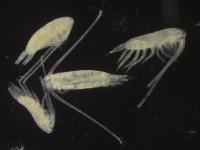
(Photo: Huntsman Marine Science Centre)
Calanoid Copepod
Calanus finmarchicus
A large copepod, but small to us and only clearly visible under a microscope. Adult females are 2.4 to 4.2 millimetres in length and males are 2.6 to 4.0 millimetres in length. Cylindrical body with antennae and a short urosome (abdomen) relative to the rest of the body. The prosome (the main part of the body) is elongate and oval-shaped. About 40% of the prosome size is the head.
Authority
Gunnerus, 1770
Classification Details
Phylum: Arthropoda (arthropods); Subphylum: Crustacea (crustaceans); Subclass: Copepoda (copepods).
Habitat
Very common across the North Atlantic, from Canada to Iceland, and also in the North Sea and the Norwegian Sea. They live in the water column and dominate the zooplankton in this area. They perform diel (24-hour period) vertical migration triggered by light. They migrate down out of the light zone at dawn to avoid being eaten by visual predators. Then they migrate back up again at dusk to feed.
Diet
Grazer, feeding on phytoplankton, but will also eat protists.
Reproduction
Sexes are separate. After spawning in spring, eggs hatch into free-swimming larval forms called nauplii. These do not resemble the adult form. After the nauplii stage, they moult into a form that looks much closer to the adult: the copepodite stage. Copepodite stage five is very rich in fats and rests during winter at more than 200 metres depth. Between February and April, it moults to adult to reproduce. They produce as many as three generations per year.
Fun Facts
Calanus is the main food of many animals such as fish, birds, and whales. This includes the North Atlantic Right Whale, which is critically endangered.
Copepod means "oar-footed".
References
Johnson WS and Allen DM (2005) Zooplankton of the Atlantic and Gulf Coasts. Maryland: Johns Hopkins University Press. Michaud J and Taggart CT (2007) Lipid and gross energy content of North Atlantic right whale food, Calanus finmarchicus, in the Bay of Fundy. Endangered Species Research 3, 77–94. Sören Häfker N, Teschke M, Last KS, Pond DW, Hüppe L and Meyer B (2018) Calanus finmarchicus seasonal cycle and diapause in relation to gene expression, physiology, and endogenous clocks. Limnology and Oceanography 63, 2815–2838.

